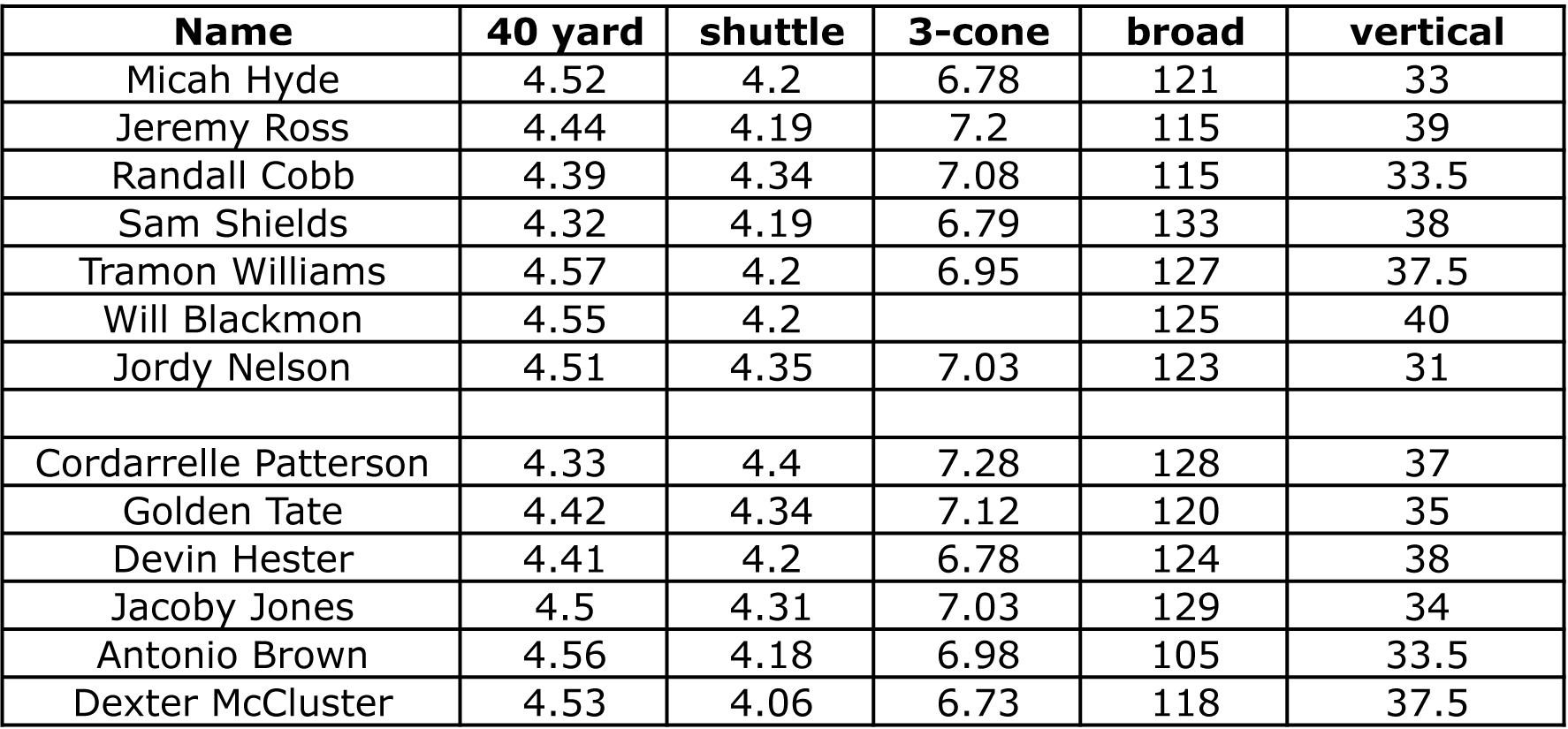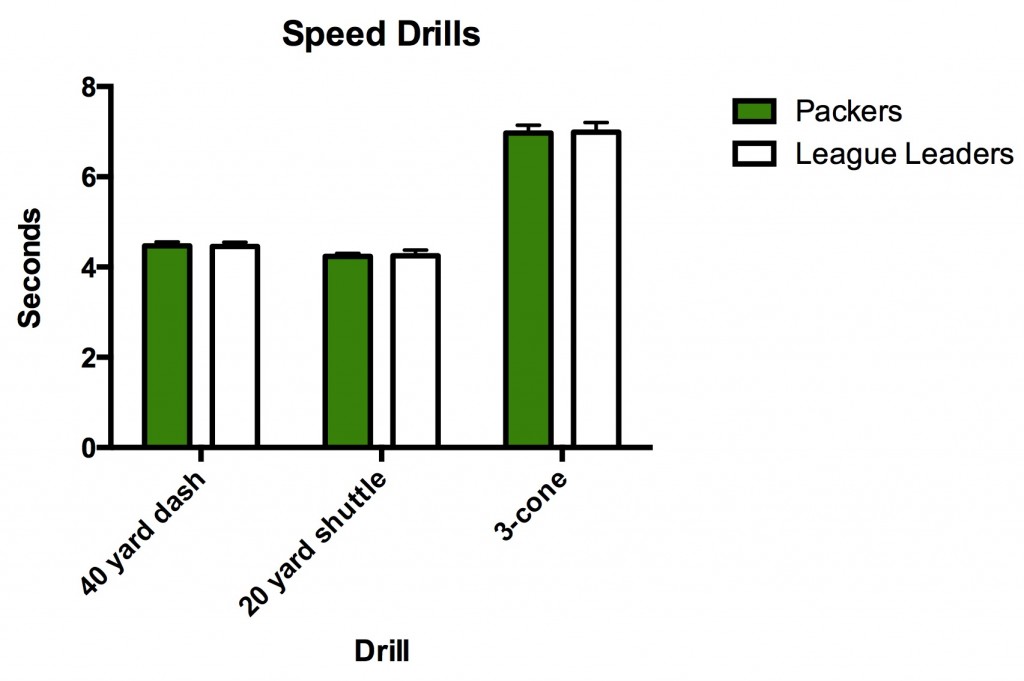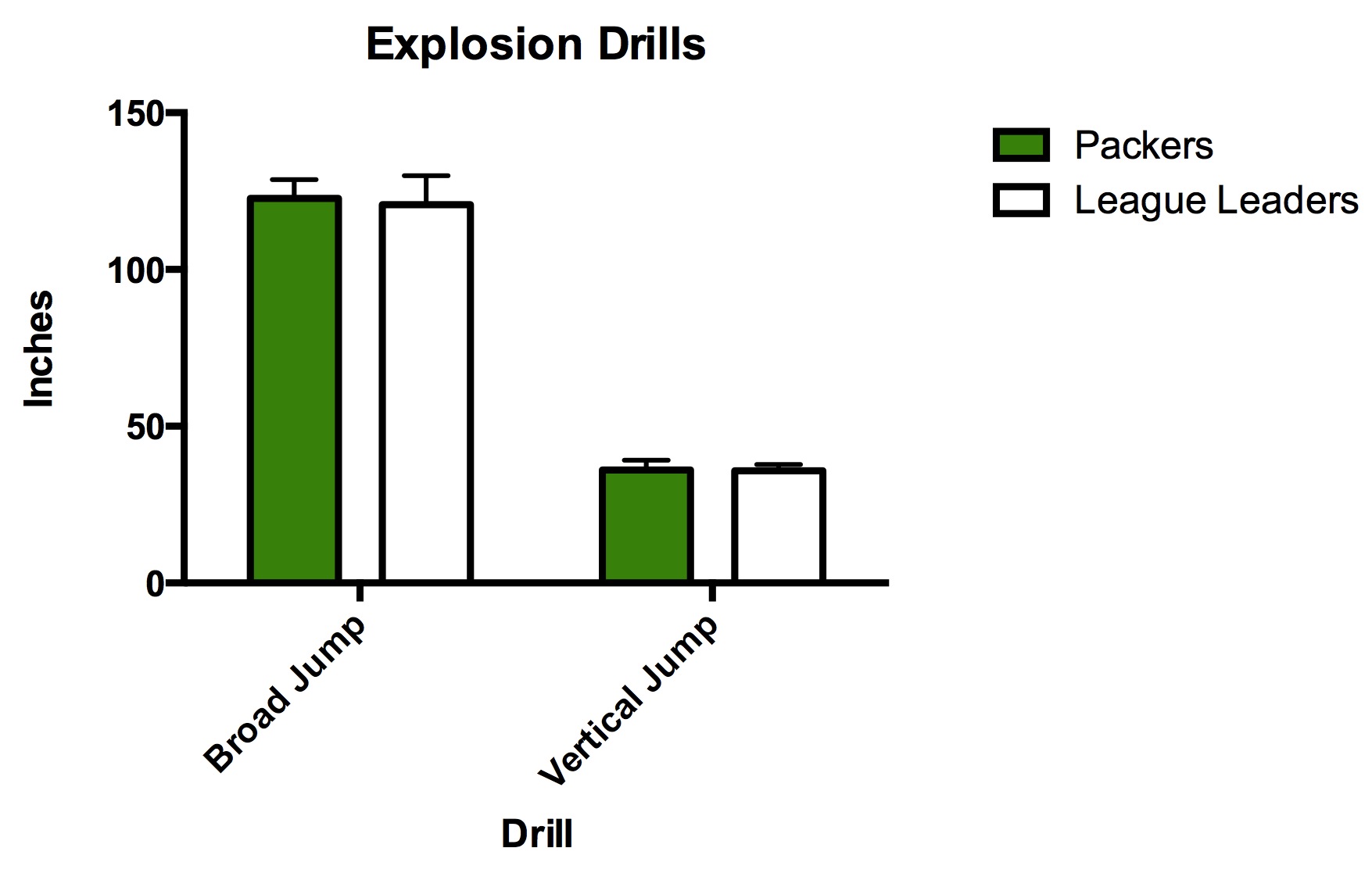
 With the selection of Jared Abbrederis by the Packers in the 5th round, fans all over Wisconsin gushed that one of their own was finally picked by the Packers. Fans were quick to heap praise on Abbreferis’ try hard attitude, underdog story and “little engine that could” mentality. Others however questioned the logic, Abbrederis was going into a loaded position and doesn’t have the physical tools to really contribute right away. How about as a returner?
With the selection of Jared Abbrederis by the Packers in the 5th round, fans all over Wisconsin gushed that one of their own was finally picked by the Packers. Fans were quick to heap praise on Abbreferis’ try hard attitude, underdog story and “little engine that could” mentality. Others however questioned the logic, Abbrederis was going into a loaded position and doesn’t have the physical tools to really contribute right away. How about as a returner?
Lacks elusiveness and is a straight line athlete. He will catch the ball and get some yards (what its blocked for) but he won’t be a good returner that can make plays, just a guy that won’t make mistakes. If your ok w/ that from a return man that’s up to you. I prefer a little more. – Stroh 2014/05/10 17:51
Challenge accepted! I think the question before addressing whether Abbrederis could be a good returner for the Packers is first to look at what kind of players the Packers typically like. I would argue that the Packers do not seem to be very fond of speed/jitter-bug returners that are currently in vogue like Dexter McCluster, Quintin Demps, Trindon Holliday, Tavon Austin etc (interestingly not many of these types of players did all that well in returning last year). Randall Cobb might be the closest player to that mold, but I would argue that Cobb had a much better and diverse skill set than any of the players I just listed. What I decided to compare combine/pro day results of notable Packers returners from 2008-2013 to the top ranked returners from the 2013 season based on ProFootballFocus metrics (I excluded some players who had incomplete combine/pro day numbers to make analysis a little more straight forward).
The combine/pro day drills I chose to look at were the 40 yard days, which measures straight line speed, the 20-yard shuttle and 3-cone, which measures agility/flexibility and finally the broad and vertical jumps, which measure acceleration. I didn’t analyze bench press for instance because I felt it was largely irrelevant to being a good returner, who typically don’t block or tackle anyone.
Overall, the results are pretty striking; there is no difference between Packers returners and the league leaders in 2013 when it comes to testing results. I ran Student’s t tests on every drill and all showed statistically no significance (which should be obvious just by looking at the graphs). So why do the Packers always have troubles with returners? The answer is a little surprising, the Packers really don’t have a problem at returner. According to ProFootballFocus, the Packers have had a top 13 returner 5 out of the last 6 years, with Will Blackmon ranking 3rd in 2008. In 2013 alone, Micah Hyde ranked as the 13th best returner in the league; while 13th obviously doesn’t mean one of the best, it also means that the Packers aren’t as terrible as many of us make them out to be.
Finally, we bring back our analysis to Jared Abbrederis, who may or may not be good enough to be a returner in the NFL. Based on his combine numbers, he falls well within range of all the drills analyzed, notably he would be among the fastest in the 20-yard shuttle and one of the worst in vertical jump. I would argue that Abbrederis’ biggest disadvantage in becoming a returner would be his long history of concussions, but for the sake of this analysis I didn’t factor that in.
My personal preference is I’d rather have a returner that gives Aaron Rodgers the ball at the 25-30 yard line every time versus a returner that sometimes takes it to the house while other times gets trucked at the 5 yard line. Arguably Abbrederis is a prime candidate in that sense since the player he’s potentially replacing, Micah Hyde, is also the same type of returner (i.e. steady and gets what’s blocked). In the end, Abbrederis hasn’t played a snap in the NFL yet and it remains to be seen how he fares, but I would predict Abbrederis already a front runner on returns.
——————Thomas Hobbes is a staff writer for Jersey Al’s AllGreenBayPackers.com.
——————




The charts you can put where the sun doesn’t shine. There is so much more that goes into a returner. If and that is a big word, if the blocking is there and no one gets a flag, Jared could get us good position. So this pre-guessing writes and charts are just to fill up your space until the seasons begins. Makes good reading and that is about all.
I disagree with your opinion and negative things to say about this article.
The fact is that there are only 46 active roster spots on game day. Therefore, most teams don’t have the luxury of having a player who only returns kicks. They have to take a skill player, who’s preferably not a starter due to increased injury risk, to return kicks. He’s probably a good athlete who returned a little in college. Elite college returners, such as Randall Cobb, are probably in an NFL starting lineup, so they don’t return much anymore these days.
That’s why there’s parity in the return game. Teams that did have an elite returner, such as Devon Hester, got the explosive plays, but at the expense of other roster spots. They only had one viable receiver for years. When they finally got more receivers, Hester had to go. Desmond Howard in 1996 was a luxury that is no longer viable for many teams.
Plus, punters are getting really good at hang time and directional kicking, minimizing the returns.
I believe you disagree is that it’s your writing and opinion. Like everything else in life you have the right to say and write what you believe but also opinions are like butts, everyone has one! It mades good talking around the campfires till the season starts and opinions fly out the window. I still enjoy your opinions!
I’m very interested in your comment actually, if this article is empty fluff then why bother commenting? If the article is pointless, what does that make your comment?
I would say that this is true reporting. A quality article that gave quality information to consider.
Shocked by the outrage. Seemed like a bit of over reaction. I reread your reaction and am laughing out loud. Seriously!
Again, i thought it was a good article.
What makes a good returner is not necessarily the elite combine skills, but whats happening between the returners ears.
He must recognize whats happening in front of him, make a decision and have the confidence to go for it. Any hesitation can lead to disaster, example Jeremy Ross. (The Packer version, not the Lions).
I think you hit it pretty much on the head: the things you can’t measure–vision, recognition, decisiveness, determination–are likely as important as the measureables.
Agility likely outweighs speed, since most defenders are running in the opposite direction and, if they miss, run themselves out of the play.
I’d argue that it’s not vision, decisiveness or determination, but insanity. How else can you explain some of the incredibly stupid returns that for some unexplained reason turn into long gains or touchdowns?
I was going to say exactly the same thing, and I think Thomas’ data helps to support this. That thing called “vision” is hard to measure quantitatively.
Sounds like you are referring to both punt and kickoff returns. If our returners have the same physical ability as top returners, then one could argue that GB should look hard at the coaching of special teams. I attribute some of our mediocre production to injuries disrupting personnel and to the limits of measurables. There are always prospects with great times who are not football players.
I agree 100% with this analysis, and probably means the Pack should take a look at the special teams coaches!
Quickness is the most important, more than straight speed. But measurements don’t make a great returner. Its called instincts and elusiveness that make a great or good returner. Toss most of the measurable out the window except maybe the quickness.
Instincts and elusiveness are intangibles that can’t be measured.
Instincts can’t but I would argue that elusiveness can, speed, agility and flexibility can all be measured. I think the bigger issues is players knowing how to be elusive.
I don’t think you can teach elusiveness either. How to you teach someone to make a small body position change when going thru a crowd to avoid a hit/tackle? You can’t teach that, its something that can be acquired maybe thru a lot of experience, but not taught. You can’t teach someone how to make themselves small is a crown so they can come out the other side. IMO its mostly an innate ability.
That is actually what I thought was so good about this article. It demonstrated that it was not strictly the measurables that determines the quality of the returner. Which then opens the door to discussion.
Stroh said…
“Instincts and elusiveness are intangibles that can’t be measured.”
I agree. How many remember when Jordy Nelson was used as a KR and PR? His KR numbers were adequate, at best, and his numbers as a PR were not good.
Elusiveness, IMO, as a KR/PR is due, in part, to size. Nelson didn’t do well as a PR due to his size. He was an easier target to find, then tackle. Cobb is smaller, harder to find, thus more elusive.
Abbrederis will have the same challenge.
I think it can be measured, but only by the results. A returner who gets better results is better…At least that’s what Captain O tells me.
Quantifying what makes a returner better…this article hits it on the head by showing how great of a task that would be.
If we are going to ignore ST coaching as a factor, why do we bother having a ST coach with an assistant? Ours is so bad that we have to keep roster spots for ST players that are are not much good at anything else.
If we had a good ST coach, we could keep better backups for other positions….and have better ST results, with fewer excuses every week.
Which team doesn’t keep players purely for special teams? I would argue that the Packers actually have very few players who are career special teams players; the only one I can think of is Jarrett Bush (outside kicker and punter naturally). Some teams have a field goal kicker and a kick off specialist for god sakes.
You can add Ryan Taylor as a career ST player. He and Bush are almost strictly kept and paid for their ST value. Nobody believes that Taylor has any use as a TE on offense. Hell Taylor was drafted for his ST prowess at NC.
I heard a very different story about Ryan Taylor’s recruitment when I talked to his parents during his rookie season at training camp. Nice people, too.
He was a ST ONLY player for 3 college seasons and had only moderate success as a Sr TE. That isn’t enough to warrant using a draft pick on as a TE. The reason he was drafted at all was his ST play. Nothing he did in college as a TE or at TE for the Packers suggest any worthwhile ability at that position.
Of course his parents would say otherwise. Their his parents.
We also can’t forget that the other 10 players blocking for the returner have a lot to do with the results, as well.
Exactly. Look at some of the HUGE lanes Desmond Howard had to run through during our special teams glory years. Gilbert Brown could have had some nice returns through those holes.
Ding! Ding! Ding! Chicken dinner.
Return men are hugely overrated. It’s about blocking.
I’m not even going to attempt to make a metric for the other 10 guys, I don’t even know if they have a position name. Like what is the guy called who plays 3rd from the left on the front line on kickoffs? Not a clue.
I would love to see if there is a correlation between say, average return team speed, strength, even weight to success. Do all return teams utilize the same weight? Strength/speed ratios?
Do the successful teams use their players differently? I know MM loves the TE and LB positions for special teams. Desmond Howard didn’t have 3-4 defensive guys blocking…and that seemed to work just fine.
Like I said Abbrederis will get what is blocked for. Just won’t get more…
Just so no one thinks I’m the only one w/ this opinion of him…
NFL “Straightlinish after the catch — pedestrian agility and elusiveness.” He has a player ranking of 5.2 per NFL, which is the very bottom of “NFL backup or special teams potential”
According to the chart,the only difference between the success and failure of a teams returner is…the dreaded block in the back flag which seems to occur on 90% of them.
Straight line speed is great if he gets past the maze and agility and vision is great as long as he doesn’t set his blockers up for a penalty.
The block in the back flag seems pretty pandemic in the NFL, I think it’s simply a really easy one to get penalized on due to the nature of returns i.e. lots of people moving in one direction and then suddenly reversing their motion.
SP teams has alot more to due with the other 10 guys on foeld than they get credit for. But for what is worth, i think for Packers return man 9not rest of SP players)it comes down to couple simple rules –#1 protect ball -above all else dont fumble, you can forget every thing else-dont fumble. #2-for kickoffs-get ball past 25 yd line if u return it while protecting ball. #3 protect ball. # 4 protect ball #5 protect ball #6–well u get idea…
I agree, and I think the Packers concur, Jeremy Ross is capable of a couple big returns every year, but he’s also going to kill the Lions twice a season. I’d rather have a guy who gets to the 25 every time and falls down.
Field vision seems to be almost like a gift some people are born with. It further seems to be something that is difficult to quantity and almost impossible to teach. Perhaps instructing QBs to go through their progressions is a form of teaching it. Nevertheless, the really good returners seem to have great field vision, along with the really good safeties.
True, but some quarterbacks have field vision and some don’t. My feeling is that it can be developed somewhat but I agree that it’s just a talent. Also, vision on returns is a lot more complicated than with quarterbacks; quarterbacks have a system of where to look and they know their receivers should be roughly as opposed to returns which are a lot more free form.
The thing that my dad used to rant about (and I think he’s right):
Just start forward immediately upon securing the ball — at least for punt returns.
If there’s nothing there, you’ll at least go forward some.
If you dance around before taking off, you’re not picking up any speed, and you’re a slow-moving target.
Very easy for the 10 defenders to zero in on.
Start with getting rid of Coach Scrotum..another example of MM maintaining a group of horrible teachers forevahhh! This guy, Campen,Perry (worst safeties in history!) Moss who’s been promoted (worst ILB’s in history!)and Capers. Ross goes to Detroit and bingo, he’s gone….think it just may be the blocking scheme/technique being “taught” year in and year out?
I gave you a +1 Mr. donut because I share some of your sentiments, especially regarding Slocum…
Abbrederis will be the opening day return specialist, book it! 😉
What I don’t get is when the return man fair catches at the 5 or 6 yard line! Wouldn’t it make sense to let it hit and chances are you get it on the 20? If the other team can down it on the 2 you’ve lost just 3 or 4 yards. I just plain don’t get it, someone explain?
I’ve not seen one comment regarding injuries. In conjunction with the other 10 guys blocking for him sentiment, when they are changing every week because one of them is now a starter, it’s very hard to build continuity. Continuity is the basis for understanding the timing of when to hit the hole or if the hole is even there to begin with.
hey there and thank you for your info – I’ve certainly picked up something new from right here. I did however expertise a few technical issues using this site, as I experienced to reload the site many times previous to I could get it to load correctly. I had been wondering if your hosting is OK? Not that I am complaining, but slow loading instances times will very frequently affect your placement in google and can damage your quality score if ads and marketing with Adwords. Anyway I am adding this RSS to my e-mail and can look out for much more of your respective exciting content. Ensure that you update this again soon..
Excellent article, there are so many elements to the return game. First of all is ball security (not touched on much in the posts), that is why Ross is in Detroit. The next element is deciseiveness, the feel to instantly pick the best path no matter what the SP team call is. From that point on quickness, elusiveness, balance (taking a hit like Cobb does many times and not going down) and then straight line speed. Blocking is certainly a key element, the days of a “wedge” that included Skoronski, Kramer, and Gillingham we won’t see any longer because of the risk factor along with the rule changes in regards to the “wedge” that limit the returns. There still has not been a more exciting returner in green & gold than the “Road Runner”, I believe in uniform on the field he was the fastest man in the NFL, not Bob Hayes at that time.
Lets not discount Jeff Janis.
All the red and white glasses viewing abbrederis need to use some peripheral vision and look out for the Saginaw Valley State flash.
Abbrederis will have a very difficult time beating out Dorsey for the last WR spot on the 53.
I never thought I would ever say this, but…
I sure miss Roell Preston!